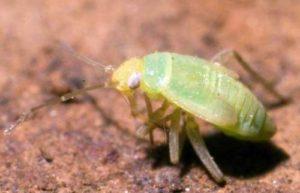Aphids on cabbage: how to treat the cruciferous family for protection
Cabbage can be called one of the most sought-after crops. It is added to salads and hot dishes. In this regard, a very crop of cabbage must be protected from pests. The real threat is the cabbage aphid.
Content
Description of the pest
Name: Cabbage aphids
Latin: Brevicoryne brassicaeClass: Insects - Insecta
Negative poison: Hemiptera - Hemiptera
family: Real aphids - Aphididae
 | Habitats: | temperate climate |
 | Features: | massively infects cruciferous |
 | Harm: | threat of crop loss up to 60% |
The body of the aphid can be oval or pear-shaped. The size ranges from 1,8 to 2,3 mm. The oral apparatus is of a piercing-sucking type. There are individuals with and without wings.
The founder is similar to subsequent individuals. She has a large body with several pairs of paws and spitz. Wings are missing. Color greenish. There is a gray waxy coating on the body.
The size of the wingless virgin is from 1 to 8 mm. The body has a broad ellipsoidal shape. The color is pale green. The head is brown. From the first segment of the abdomen there are transverse brown stripes. Antennae and legs of identical shade.
The size of the winged virgin is from 1,5 to 2,3 mm with an elongated ellipsoid body shape and gray pollination. Head, whiskers, legs brown. The belly is yellow-green. The abdomen has brown transverse stripes and marginal spots. Whiskers are longer than those of wingless individuals.
The size of the amphigon female is from 1,8 to 2 mm. The body is grassy green without pollination. There is a brownish spot on the head and segment 8. Thorax and belly with dorsal spots.
Male winged individuals are 1,4 to 1,8 mm in size. On the yellow or yellow-green abdomen there are 4 rows of brown and black marginal spots.
The eggs are black and shiny. The shape of the eggs is oval-elongated.
Life cycle
aphid reproduces very quickly and rapidly. Here is how the whole life cycle happens:
- The place of wintering of eggs is the stems, the base of cabbage leaves, wild-growing weeds of the Cruciferous family.
- The period of birth of larvae falls on the end of April - the beginning of May.
- From 10 to 15 days they feed. After that, they become founding females. Each female is capable of producing up to 40 individuals.
- The pest is located on a stalk or leaf blade. Thanks to partogenesis, wingless virgins appear.
- After 2 - 3 generations, winged females appear. Insects migrate to other plants. Next come the males. After a mating period, the females lay eggs for the winter. During the year there can be up to 20 generations.
- The optimum temperature range is from 22 to 26 degrees Celsius. Humidity should be around 60%. Hatching of larvae is promoted by temperature from 7 degrees of heat.
- Under the snow, the insect can withstand up to 15 degrees of frost. Egg laying ends at temperatures below 14 degrees.
Habitat and distribution
Cabbage aphids can be found in any country in the world. A huge number inhabit Europe, Central Asia, North America, North Africa, Australia, New Zealand. The only exception in the Russian Federation is the Far North.
It is worth noting that in the subtropical climate, the full development of individuals does not occur. Insects do not live in such latitudes.
Economic importance
The cabbage aphid is the most dangerous enemy of the Brassicaceae. Damages cabbage and radishes the most. The insect also feeds on radish, yarutka, shepherd's purse, colza, rape, mustard.
The pest sucks the juice, there is a curvature of the testicles and a developmental lag. The leaves begin to turn yellow and discolor. The ovaries of heads of cabbage develop for a long time and do not gain weight. They show sticky discharge. Aphids are carriers of viruses. With mass reproduction, the share of the crop can be reduced to 60%.
External signs of appearance
Parasites suck juice from cabbage leaves. Damaged foliage becomes colorless with a pinkish tinge. Gradually, the leaves die off. As a result, the cabbage head is not formed. An insect colony is similar to ash or ashes.
Pad or aphid secretions cause plant rot. Brussels sprouts strike very deeply. Beijing cabbage is deformed. It takes on a domed shape.
It is worth noting that the aphid is a carrier of more than 20 viral diseases, which affects the reduction in yield.
Methods of struggle
- Infected plants must be destroyed.
- Attract hoverflies and ladybugs. To do this, plant allisum, cilantro, dill.
- Garlic decoction treatment will also be very effective. To do this, 0,8 kg of garlic is crushed with a meat grinder. Add 10 liters of boiling water. This mixture is boiled for 2 hours. The solution is diluted in half with water and sprayed.
- Of the biological products, the use of Bitoxibacillin, Actofit is appropriate. In case of mass damage, chemical insecticides Full House, Movento, Prime, Actellik, Borey are suitable.
- You can use folk decoctions with wood ash, tobacco, potato tops and onion peel. The simplest is soapy water.
- To agrotechnical methods can be attributed:
- timely weed control;
- proper cultivation of crops;
- destruction and burning of plant residues;
- deep digging of the earth, autumn plowing and harrowing in the spring;
- planting plants that will scare off parasites with their aroma (tomatoes, carrots).
List of 26 aphid control methods will help you choose the appropriate pest control method.
Conclusion
The appearance of cabbage aphids threatens serious damage in agriculture. When the first signs are found, any of the methods is chosen and the cabbage is processed. However, preventive measures will prevent the invasion of unwanted insects on the site.

